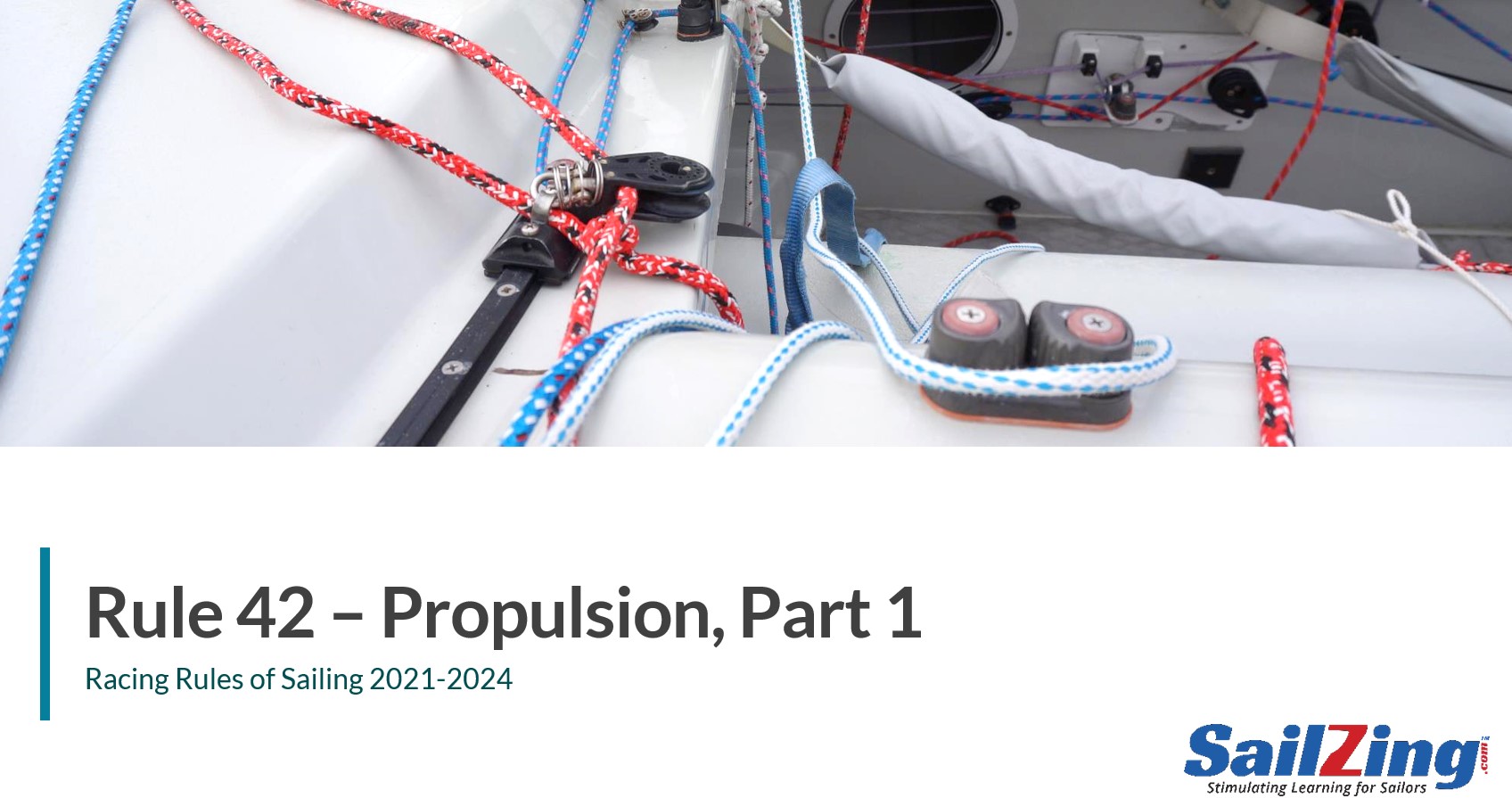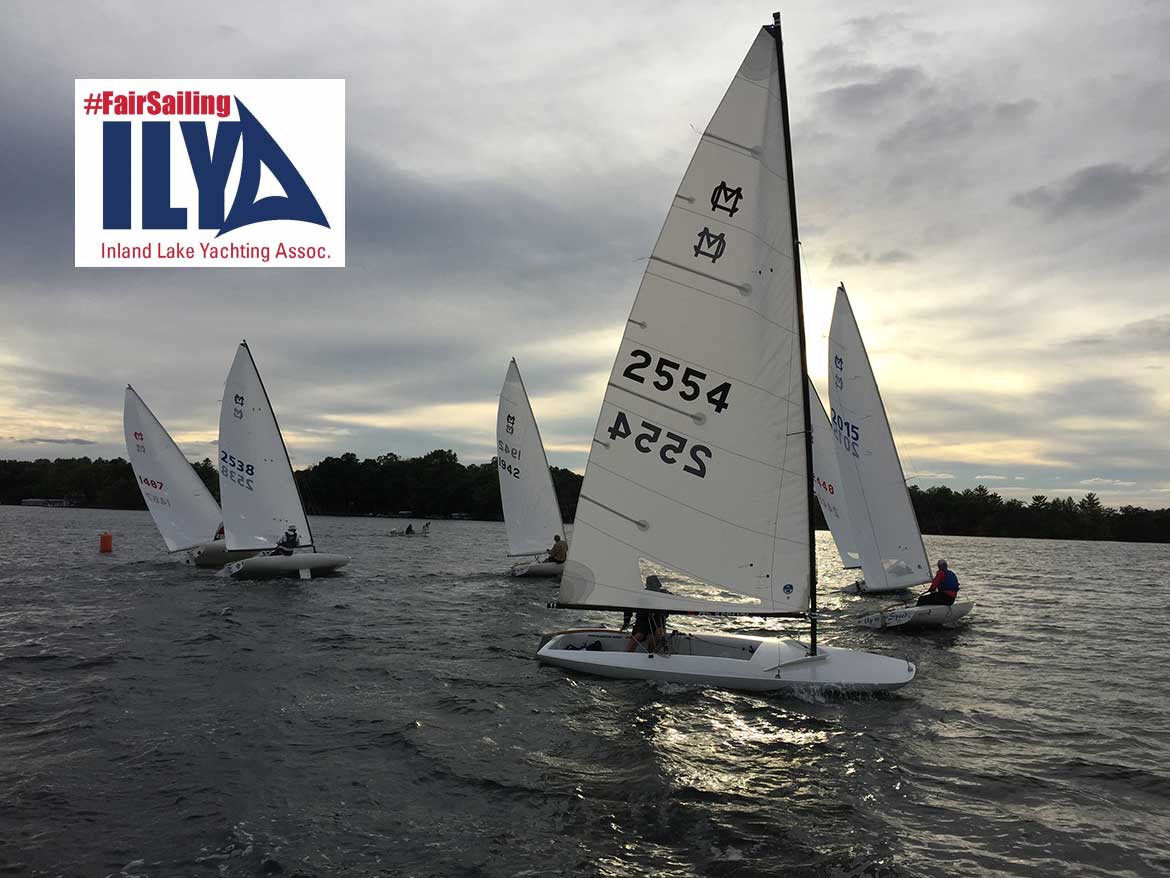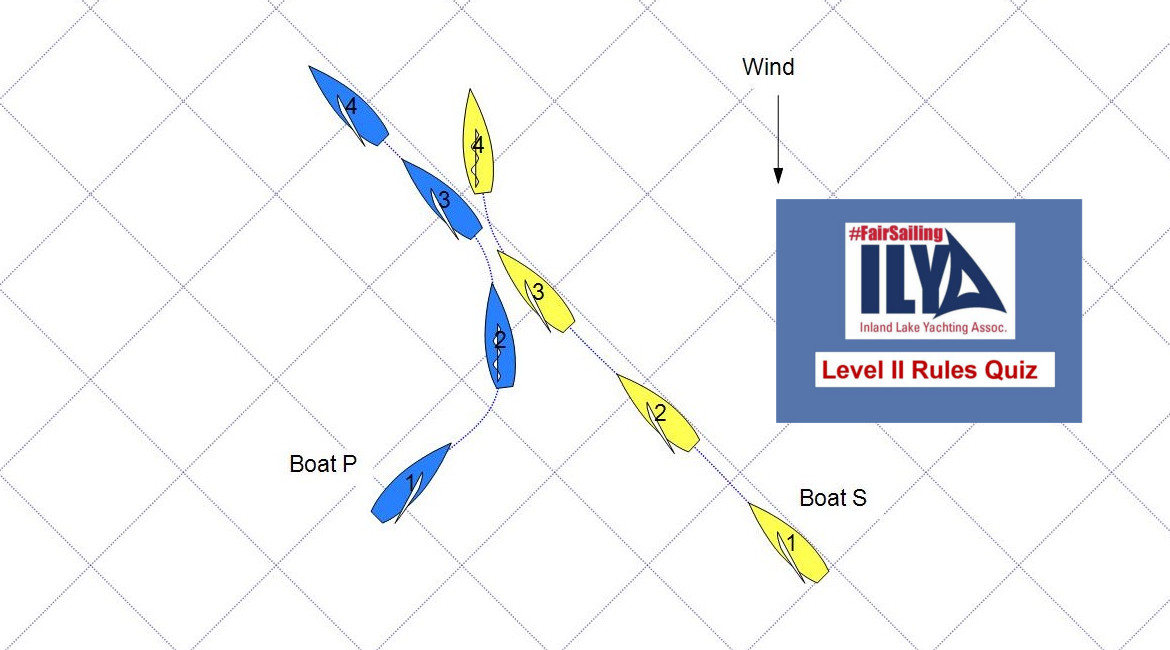Rule 42, Propulsion, addresses permitted and non-permitted ways to affect the boat’s speed while racing. Propulsion is sometimes referred to as kinetics.
Many sailors don’t understand or apply the rule correctly for a variety of reasons:
- Lack of education and enforcement. On-water umpires are used at high-level events. At lower-level events, self-enforcement is expected but mostly ignored, leaving average sailors no incentive to learn the rule.
- Lack of experience, mostly because it applies only to small dinghies and may not be taught properly.
- Subtleties of interpretation since the rule is complex, with some judgment required.
For this post, we assembled and organized all the available Rule 42 resources, including the rule, “official” interpretations, World Sailing cases, video examples, and commentary from several authors. See the related content section for a list of sources.
We begin by presenting definitions and the rule, along with interpretations from World Sailing’s Interpretations of Rule 42, Propulsion (May 2013) and relevant cases from the World Sailing Casebook. Then we provide video examples of common rule violations.
Because Rule 42 is complex, we’re presenting it in two parts. In part 1, we’ll cover definitions and Rule 42.1 (basic rule) and 42.2 (prohibited actions). In part 2, we’ll cover Rule 42.3 (exceptions).
To watch a video version of this post, click on the image below or go to our YouTube Channel.
Rule 42 “Definitions”
These definitions are from Interpretations of Rule 42, Propulsion (May 2013)
- Repeated means more than once in the same area on a leg.
- A pump is a single pull on a sail that is unrelated to wind or waves.
- Body pumping is the movement of a sail caused by in and out or up and down body movement.
- A flick is the effect caused by body movement or pulling in or releasing a sail that is so abrupt that the normal shape of the sail is changed and almost immediately returned to the original shape.
- A roll is a single-cycle athwartship movement of the boat during which the mast goes to leeward and back to windward, or vice versa.
- Background rolling is the minimum degree of rolling caused by the waves.
- Torquing is repeated fore and aft or rotating movement of the body.
- Yellow light area is a phrase used when it is not clear that an action is prohibited. It is unlikely that a boat in the yellow light area would be penalized, but it is possible. If the action is repeated, the likelihood of a penalty will rapidly increase.
Rule 42, PROPULSION. Rule, Interpretations, and Video Examples
42.1 Basic Rule
Except when permitted in rule 42.3 or 45, a boat shall compete by using only the wind and water to increase, maintain or decrease her speed. Her crew may adjust the trim of sails and hull, and perform other acts of seamanship, but shall not otherwise move their bodies to propel the boat.
Notes and Interpretations (Rule 42.1)
- Except when permitted under rule 42.3, any single action of the body that clearly propels the boat (in any direction) is prohibited. (Basic 4)
- We’ll cover Rule 42.3 (exceptions) in Part 2 of this post.
- Rule 45 covers anchoring (not covered here since it is not common).
- Momentum of a boat after her preparatory signal that is the result of being propelled by her engine before the signal does not break rule 42.1. (Case 69).
Video Example
Here is one simple example of propulsion that is prohibited by Rule 42.1. We see others as we go through Rule 42.2.
42.2 Prohibited Actions
Without limiting the application of rule 42.1, these actions are prohibited:
Notes and interpretations (Rule 42.2)
- An action that is not listed in rule 42.2 may be prohibited under rule 42.1. (Basic 1)
- A kinetic technique not listed in rule 42.2 that propels the boat and is not one of the permitted actions covered in rule 42.1, is prohibited. (Basic 2)
- An action prohibited in rule 42.2 cannot be considered as permitted under rule 42.1 (Basic 3)
- An action listed in rule 42.2 is always prohibited, even if it fails to propel the boat. (Basic 5)
Pumping
(a) pumping: repeated fanning of any sail either by pulling in and releasing the sail or by vertical or athwartship body movement;
Notes and Interpretations (Pumping)
- PUMP 1: Fanning is moving a sail in and out not in response to wind shifts, gusts, or waves.
- PUMP 2: Pulling in and releasing a sail in response to wind shifts, gusts or waves is permitted, even if repeated (see rule 42.1).
- PUMP 3: Except when permitted under rule 42.3(c), one pump may be prohibited under rule 42.1.
- PUMP 4: A flick of a sail resulting from the sudden stopping of an eased sheet is permitted.
- PUMP 5: One flick of a sail due to body pumping, or a pump not permitted by rule42.3(c), is in the yellow light area. Body movement that does not result in a flick of a sail does not break rule 42.2(a), but may break other parts of rule 42.
- PUMP 6: Repeated flicks of a sail due to body pumping are prohibited.
Video Examples
Rocking
(b) rocking: repeated rolling of the boat, induced by
(1) body movement,
(2) repeated adjustment of the sails or centerboard, or
(3) steering;
Notes and Interpretations (Rocking)
- ROCK 1: A roll of the boat caused by a gust or a lull followed by a corrective body movement to restore proper trim is permitted by rule 42.1.
- ROCK 2: One roll that does not clearly propel the boat is permitted.
- ROCK 3: Background rolling is permitted. Boat’s crew is not required to stop this type of rolling.
- ROCK 4: Adopting any static crew position or any static setting of the sails or centerboard, even when stability is reduced, is permitted by rule 42.1 and is not prohibited by rule 42.2(b).
- ROCK 5: A single body movement that is immediately followed by repeated rolling of the boat is prohibited.
Video Examples
Ooching/Torquing
(c) ooching: sudden forward body movement, stopped abruptly;
Notes and Interpretations (Ooching)
- Rule 42 prohibits ooching.
- For college sailing, the ICSA permits ooching downwind to facilitate planing or surfing, only if planing or surfing is possible.
- OOCH 1: Torquing to change the fore and aft trim of the boat in phase with the waves is permitted, provided it does not result in pumping the sails. (For example, this allows you to lean back when climbing the face of a wave and lean forward to accelerate down the back of a wave.)
- OOCH 2: Torquing on flat water is prohibited.
We did not include video examples for ooching and torquing.
Sculling
(d) sculling: repeated movement of the helm that is either forceful or that propels the boat forward or prevents her from moving astern;
Notes and Interpretations (Sculling)
- While sculling is generally not permitted, there is a significant exception in Rule 42.3. We’ll cover it in Part 2, with video examples)
Repeated Tacks or Gybes
(e) repeated tacks or gybes unrelated to changes in the wind or to tactical considerations.
Notes and Interpretations (Repeated Tacks and Gybes)
- There are no official interpretations for this topic. Note that you can tack or gybe repeatedly in response to changes in the wind or for tactical reasons.
Related Content
Interpretations of Rule 42, Propulsion (May 2013) – World Sailing
World Sailing Casebook
Video – Top 5 Rule 42 Mistakes and how to avoid them in Single-Handed Dinghy Racing – RYA
Video – Common Breaches of Rule 42 – Finn Class
Understanding Rule 42 – AeroNautic
Rule 42 Downwind Sailing Explained – ISA
Rule 42 Most Common Breaches: Laser Standard, Laser Radial and Laser 4.7 – ISA
Guidelines for on-the-water Rule 42 Enforcement at ICSA Events
RRS | World Sailing Judges Manual
100 Best Racing Rules Quizzes – Dave Perry – Quizzes 54-59
SailZing Racing Rules Posts





